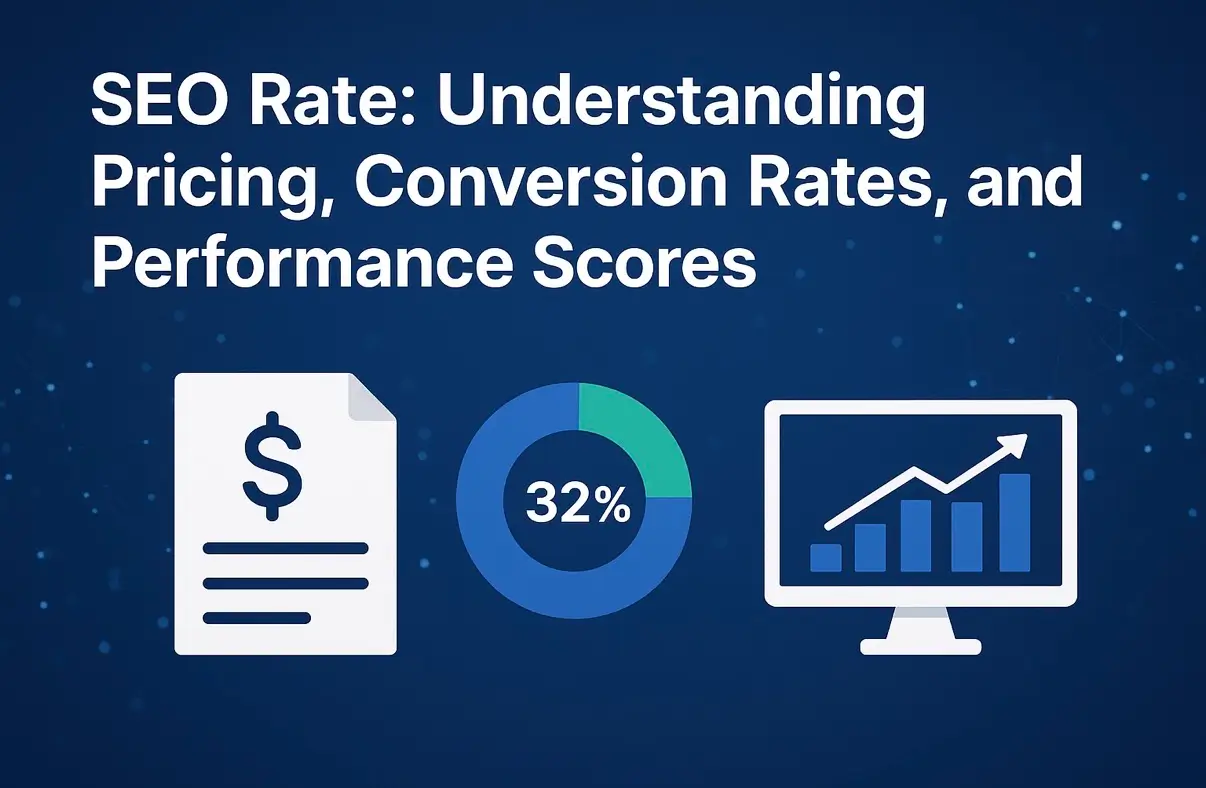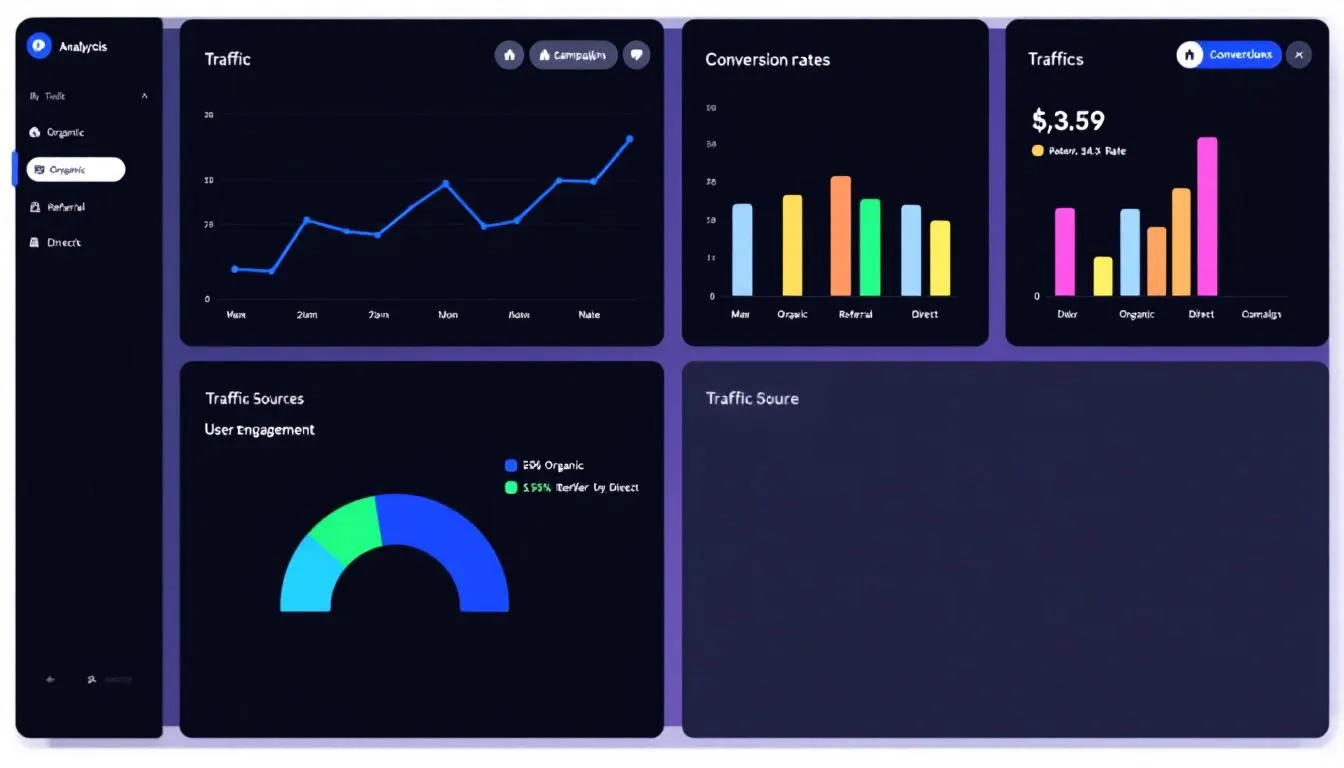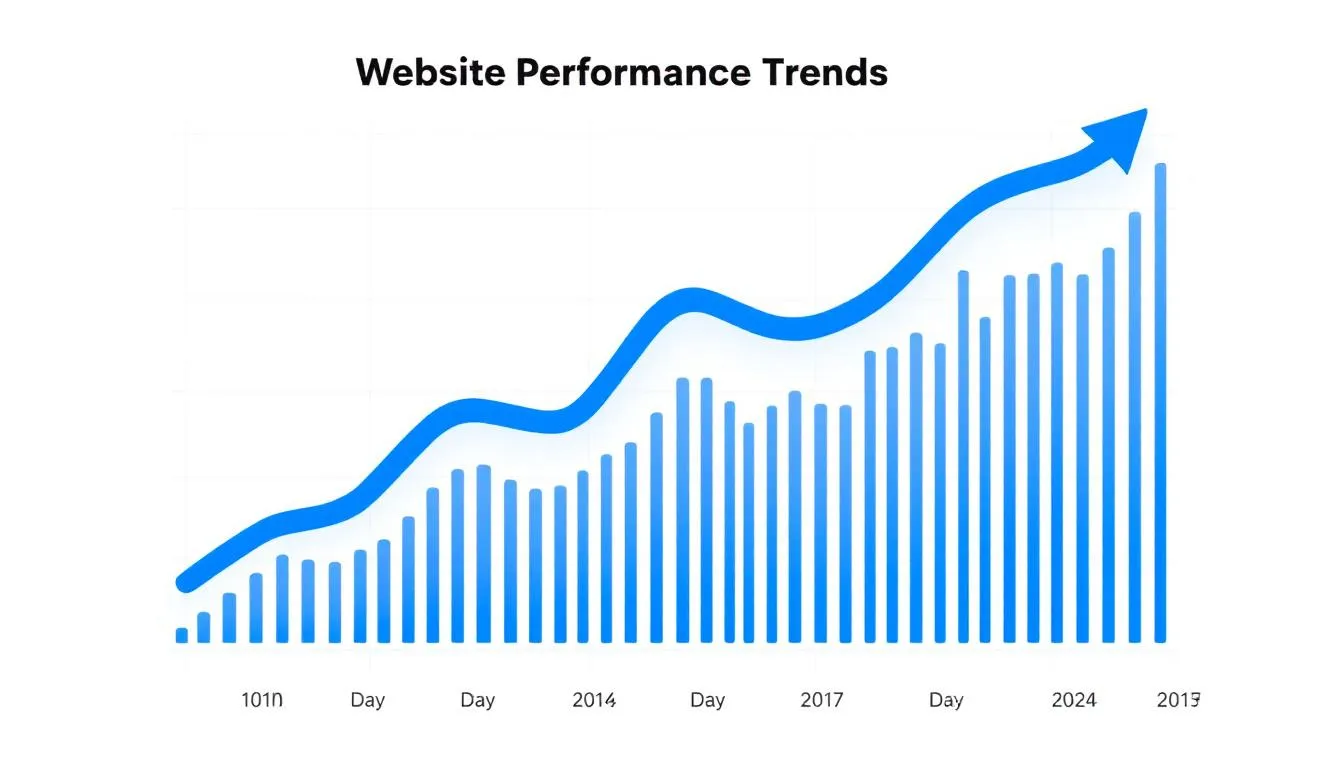SEO Rate: Understanding Pricing, Conversion Rates, and Performance Scores in 2025

Sarah, owner of a growing dental practice, recently told me she was “completely lost” when it came to understanding SEO rates. Three different seo agencies quoted her everything from $300 to $3,500 per month, while her marketing consultant kept talking about “improving her conversion rate” and her web developer mentioned something about “SEO scores.”
Sound familiar?
The term “seo rate” gets thrown around in so many different contexts that it’s no wonder small business owners feel confused. Are we talking about what you pay for seo services? Your website’s conversion rate from organic search traffic? Or perhaps your site’s SEO performance score from various seo tools? With the rise of answer engines and Google’s evolving algorithms, businesses now also need to consider optimizing for AI-powered search features and aligning their SEO strategies with Google’s standards to improve visibility. The increasing adoption of ai tools by marketing professionals for content creation and optimization is also impacting SEO strategies, as these tools help enhance content relevance and better understand user behavior.
In this comprehensive guide, I’ll break down all three types of SEO rates that matter for your business success, share real market data from 2025, and help you make informed decisions that drive actual results.

What Does “SEO Rate” Actually Mean?
When someone mentions “seo rate,” they could be referring to three completely different metrics, each critical to your marketing success:
Service Pricing Rates: What you pay seo professionals, seo agencies, or freelancers for their search engine optimization work. This includes monthly retainers, hourly rates, and project-based pricing.
Conversion Rates: The percentage of your organic search visitors who take desired actions on your website – whether that’s filling out form submissions, making purchases, or scheduling consultations. It’s important to note that the average seo conversion rate varies significantly across industries and page types. Understanding these industry-specific benchmarks helps set realistic goals for your SEO performance.
Performance Scores: Numerical ratings (typically 0-100) that seo tools assign to measure your website’s technical health, content quality, and overall optimization level.
Understanding each type matters because they’re interconnected. Poor seo performance scores often lead to lower organic traffic and conversion rates, while investing in quality seo services should improve both your scores and your bottom line.
Let me share a quick example. Remember Sarah from the dental practice? Her confusion stemmed from mixing these concepts. The $300/month provider was only promising to “improve her seo score” through basic technical fixes, but did not address the state of her existing content, such as outdated or poorly optimized materials, which can significantly impact the effectiveness and cost of SEO strategies. The $3,500/month agency focused on conversion rate optimization and comprehensive content creation. The middle option at $1,800/month offered a balanced approach targeting both technical improvements and lead generation.
After six months with the middle-tier provider, Sarah’s organic traffic increased 180%, but more importantly, her conversion rate improved from 2.1% to 4.7%, generating 12 new patient appointments monthly from organic search.
SEO Service Rates: What You Should Expect to Pay in 2025
Based on recent surveys of over 300 seo professionals and small business owners, here’s what the market actually looks like for seo pricing in 2025.
The average monthly investment for effective search engine optimization ranges from $1,000 to $2,500 for most small businesses. This represents a 15% increase from 2023, primarily due to the complexity added by AI-driven search algorithms and the need for more sophisticated content strategies. Current seo cost trends for 2025 highlight the importance of strategic budgeting, taking into account business size and the competitiveness of your industry.
Geographic variations matter significantly. An seo agency in Manhattan might charge $4,000/month for services that cost $1,500/month in Kansas City. However, don’t assume cheaper automatically means better value – often, the opposite proves true. Allocating an appropriate seo budget is essential, and what constitutes a reasonable seo budget can vary widely, especially for small businesses.
Here’s a crucial red flag: any seo provider charging under $150/month for ongoing work is likely using automated tools or outdated tactics that could harm your search engine rankings. Quality search engine optimization requires significant time investment in keyword research, content creation, technical audits, and ongoing optimization that simply cannot be delivered profitably at rock-bottom prices. Using the right tool for website analysis and technical audits is also critical to ensure effective results.

Monthly Retainer Rates
Monthly retainers represent the most popular pricing model for ongoing seo efforts, and for good reason – they provide predictable costs and consistent optimization work.
Small Business Tier ($500-1,000/month)
- Basic keyword research and on-page optimization
- Monthly technical seo audits using specialized tools
- 2-4 pieces of optimized content per month
- Google My Business optimization for local businesses
- Basic competitor analysis and reporting
At this level, you’re typically working with individual consultants or smaller agencies. The focus remains on foundational improvements and gradual organic traffic growth.
Mid-Tier Investment ($1,001-2,500/month)
- Comprehensive keyword research targeting high-value conversions
- 6-10 pieces of optimized content monthly
- Link building campaigns and digital PR outreach
- Advanced technical seo including structured data implementation
- Conversion rate optimization for key pages
- Detailed monthly reports with actionable insights
This tier often provides the best ROI for growing businesses, combining technical expertise with content marketing and user experience improvements.
Premium Level ($2,501-5,000/month)
- Full-service seo campaigns with dedicated account management
- Custom content strategies aligned with sales funnels
- Enterprise-level seo tools and advanced analytics
- Video and multimedia content optimization
- Integration with paid advertising and email marketing
- Weekly strategy calls and priority support
Case Study: Manufacturing Company Results
TechFlow Manufacturing, a B2B company selling industrial equipment, invested $1,800/month in search engine optimization starting in March 2024. Their seo provider focused on technical improvements, industry-specific content creation, and building authority through thought leadership articles.
Results after 8 months:
- Organic traffic increased 340%
- Target keywords in positions 1-3 grew from 12 to 89
- Monthly qualified leads from organic search rose from 3 to 28
- Cost per lead decreased from $340 (via paid ads) to $64 (organic)
The monthly seo investment generated an estimated $45,000 in new business over the measurement period.
Hourly SEO Rates
Hourly pricing works best for specific projects, audits, or consulting arrangements rather than ongoing optimization campaigns.
Current market rates range from $50 to $300 per hour, with most experienced professionals charging between $75-150/hour. Geographic location significantly impacts these rates – consultants in major metropolitan areas typically command 30-50% higher fees than those in smaller markets.
Experience directly correlates with pricing:
- 1-2 years experience: $50-75/hour
- 3-5 years experience: $75-125/hour
- 6-10 years experience: $125-200/hour
- 10+ years with proven results: $200-300/hour
When hourly makes sense:
- One-time website seo checker audits and technical assessments
- Server configuration reviews and optimizations as part of technical SEO work
- Identifying and resolving seo issues such as technical errors and on-page problems
- Specific seo campaign and local strategy development
- Training your internal team on seo tools and processes
- Short-term consultation on algorithm updates or penalties
- Second opinions on existing seo efforts
Red flag warning: Consultants charging $25/hour or less often lack proper experience or resort to automated tools that provide minimal value. Remember, effective seo work requires deep analysis, strategic thinking, and custom solutions that simply cannot be delivered at bargain-basement rates.
Project-Based SEO Rates
Project-based pricing ranges from $1,000 to $15,000 depending on scope and complexity, with most small to mid-sized business projects falling between $2,000-5,000.
Common project types and typical costs:
- Technical seo audit and implementation: $1,500-3,500
Note: Technical SEO audits often include a detailed analysis of each web page to identify optimization opportunities and technical errors. Some projects require a comprehensive review of the entire website to assess user engagement and navigation behavior. - Complete website migration with seo preservation: $3,000-8,000
- Local seo setup and optimization: $1,000-2,500
- E-commerce seo overhaul: $2,500-7,500
- Content strategy development and initial implementation: $2,000-5,000
Example: E-commerce Technical Overhaul
Outdoor Gear Plus, an e-commerce site selling camping equipment, hired an seo specialist for a $3,500 technical optimization project. The project included:
- Complete technical audit using specialized tools
- Site speed optimization and mobile optimization improvements
- Structured data implementation for product pages
- Internal linking strategy revision
- XML sitemap optimization
Six months post-implementation:
- Organic traffic increased 89%
- Average seo score improved from 61 to 84
- Mobile conversion rate increased from 1.8% to 3.2%
- Revenue from organic search grew 156%
SEO Conversion Rates: Measuring Your Success
Your seo conversion rate represents the percentage of organic visitors who complete desired actions on your website. The calculation is straightforward: (Total Conversions ÷ Total Organic Visitors) × 100.
However, what constitutes a “conversion” varies by business type. For legal services, it might be consultation requests. For e-commerce, it’s completed purchases. For B2B software companies, it could be demo requests or free trial signups.
Industry average seo conversion rates:
- Overall average across all industries: 2.9%
- E-commerce: 1-3% (varies significantly by product category)
- Professional services: 3-5%
- Software/SaaS: 2-4%
- Local services: 3-7%
It’s important to note that conversion rates can vary significantly depending on the page type—such as product pages, service pages, blog posts, or case studies—since each serves different user intents and goals. Other factors, including user intent and website design, also influence conversion rates.

Understanding these benchmarks helps set realistic expectations, but remember that numerous factors influence your specific conversion rate potential.
Real Example: SaaS Conversion Improvement
CloudSync, a small business file-sharing service, struggled with a 1.2% conversion rate from organic traffic despite steady visitor growth. After analyzing their organic search performance, we identified several issues:
- Most organic traffic landed on informational blog posts rather than product pages
- The free trial signup process required too many fields
- Mobile users experienced slow loading times
- Call-to-action buttons weren’t prominently displayed
Through targeted conversion rate optimization:
- Improved internal linking from blog posts to product pages
- Simplified the signup process to three fields maximum
- Enhanced mobile site speed using technical seo improvements
- A/B tested button placement and copy
Result: Conversion rate improved to 4.1% within four months, generating an additional $18,000 monthly recurring revenue from the same organic traffic volume.
Conversion Rates by Industry
Legal Services (3-5%) Legal keywords often represent high-intent searches from people actively seeking representation. Users searching for “personal injury lawyer near me” or “divorce attorney consultation” typically convert at higher rates because they have immediate needs and are ready to take action.
High-value conversions in legal services often justify significant seo investments, with some personal injury firms spending $5,000-15,000 monthly on search engine optimization due to average case values exceeding $50,000.
E-commerce (1-3%) E-commerce conversion rates vary dramatically based on product category, price points, and purchase complexity. Impulse-buy items under $50 typically convert better than high-consideration purchases like appliances or electronics.
Seasonal factors significantly impact e-commerce seo conversion rates. Holiday shopping periods often see 40-60% higher conversion rates, while January typically shows the lowest performance as consumers recover from holiday spending.
B2B Software (2-4%) B2B software conversions involve longer sales cycles and multiple decision-makers, resulting in more measured conversion rates. However, the lifetime value of B2B customers often exceeds $10,000, making even modest improvements in seo conversion rates extremely valuable.
Free trials and demos serve as micro-conversions that eventually lead to paid subscriptions, requiring sophisticated tracking to measure true seo campaign effectiveness.
Local Services (3-7%) Local services often achieve the highest conversion rates because searchers have immediate, location-specific needs. Someone searching “emergency plumber near me” at 2 AM represents extremely high-intent traffic likely to convert immediately.
Google My Business optimization becomes crucial for local service conversion rates, as most users evaluate reviews, photos, and business information before making contact.
Factors That Impact Your SEO Conversion Rate
These are important factors that influence SEO conversion rates, including compliance with search engine guidelines, website accessibility, and the overall scope of work required for effective optimization.
Search Intent Alignment Understanding the three types of search intent helps optimize for higher conversion rates:
- Informational queries: Users seeking knowledge (“how to fix a leaky faucet”)
- Commercial investigation: Users comparing options (“best accounting software for small business”)
- Transactional queries: Users ready to purchase (“buy QuickBooks online”)
Transactional queries typically convert 5-10x higher than informational searches, but informational content builds trust and authority that supports long-term conversion goals.
Page Load Speed Impact Google’s research shows that conversion rates drop 7% for every additional second of loading time. For mobile devices, the impact intensifies – 53% of mobile users abandon sites that take longer than 3 seconds to load.
Technical seo improvements focusing on site speed directly impact both search engine rankings and conversion performance, making speed optimization one of the highest-ROI activities.
Mobile Optimization With 60% of searches occurring on mobile devices, mobile user experience dramatically affects conversion rates. Mobile-optimized sites typically see 20-30% higher conversion rates than desktop-only designs.
Key mobile conversion factors include:
- Thumb-friendly button sizes and placement
- Simplified navigation and checkout processes
- Fast-loading images and minimal pop-ups
- Easy-to-read fonts and appropriate spacing
User Experience and Trust Signals Clear navigation, professional design, and prominent trust signals (security badges, customer testimonials, contact information) significantly impact conversion rates.
A/B testing different page layouts often reveals 20-50% improvements in conversion performance, making user experience optimization a critical component of successful seo campaigns.
SEO Performance Rates and Scores
Most popular seo tools assign performance scores ranging from 0-100 to evaluate various aspects of your website’s optimization. However, these scores measure technical health and optimization completeness rather than actual business results.
What SEO Scores Actually Measure:
- Technical health: Site speed, mobile-friendliness, crawlability
- Content quality: Keyword usage, content depth, freshness
- Authority signals: Backlink quality, domain age, brand mentions
- User experience: Navigation, internal linking, page structure
Important reality check: A perfect 100 score doesn’t guarantee top search engine rankings or high conversion rates. I’ve seen websites with 65 scores outrank competitors scoring 85+ because they better matched user intent and provided superior user experiences.
Real Story: David vs. Goliath Rankings
Mountain View Landscaping, a small local business, competed against a national franchise with significantly higher domain authority and technical seo scores. The franchise’s website scored 89 using a popular website seo checker, while Mountain View’s site scored only 67.
However, Mountain View’s seo strategy focused on:
- Hyper-local content addressing specific regional concerns
- Detailed project galleries showcasing local work
- Customer testimonials mentioning specific neighborhoods
- Active engagement with local community events and organizations
Result: Mountain View consistently outranked the national franchise for local searches, generating 3x more leads despite lower technical scores.
This illustrates why focusing solely on improving your seo score misses the bigger picture of delivering value to your target audience.

Key Performance Metrics to Track
Organic Traffic Growth Monitor both month-over-month and year-over-year trends, as seasonal fluctuations can mask underlying improvement patterns. Healthy organic growth typically ranges from 10-25% monthly for new seo campaigns, stabilizing around 5-15% monthly growth as your site matures.
Focus on qualified traffic rather than total visitors. A 50% increase in organic traffic means little if those visitors aren’t converting into customers.
Keyword Ranking Improvements Track rankings for target keywords that directly impact your business goals. Ranking #1 for “best pizza recipes” won’t help a local pizzeria as much as ranking #3 for “pizza delivery near me.”
Use keyword grouping to track thematic improvements rather than individual keyword fluctuations, which can vary daily due to personalization and algorithm updates.
Click-Through Rates from Search Results Position 1 in Google typically achieves 2-5% click-through rates, though this varies by industry and search type. Local searches often see higher click-through rates (7-12%) due to immediate intent.
Optimizing meta descriptions and title tags can improve click-through rates by 20-40%, effectively increasing organic traffic without improving rankings.
Domain Authority Improvements Domain authority improvements happen gradually over 6-12 months of consistent optimization efforts. Rapid authority increases often indicate unnatural link building that could trigger penalties.
Focus on earning high-quality backlinks from relevant, authoritative sources rather than pursuing quantity-based link building strategies.
Free SEO Tools and Resources
For businesses and website owners aiming to boost their search engine rankings without a hefty investment, free SEO tools and resources are a game-changer. These tools empower you to tackle everything from keyword research and technical SEO to monitoring website performance and tracking your progress in search results—all without straining your budget.
Keyword Research ToolsFinding the right keywords is the foundation of effective search engine optimization. Free tools like Google Keyword Planner and Ubersuggest allow you to discover high-potential keywords, analyze search volume, and identify new content opportunities. These resources help you target the terms your audience is actually searching for, giving your website a better chance to climb the rankings.
Technical SEO and Website PerformanceTechnical SEO is crucial for ensuring your site is accessible and optimized for both users and search engines. Google PageSpeed Insights provides actionable recommendations to improve your website’s loading speed—a key factor in both rankings and user experience. Tools like Screaming Frog SEO Spider (free for up to 500 URLs) and Ahrefs Webmaster Tools offer in-depth technical audits, helping you uncover crawl errors, broken links, and other issues that could be holding your site back.
Comprehensive SEO AnalysisGoogle Search Console is a must-have free resource for monitoring your website’s performance in search. It shows which queries bring users to your site, highlights indexing issues, and provides insights into how Google views your pages. MozBar, a free browser extension, lets you quickly check on-page SEO elements and domain authority as you browse the web, making competitor analysis and on-the-fly audits simple.
Additional Free ResourcesOther valuable free SEO tools include Answer the Public for content ideas based on real search queries, and GTmetrix for detailed website performance reports. Many SEO agencies and professionals also offer free SEO checkers on their websites, providing quick overviews of your site’s strengths and weaknesses.
By leveraging these free SEO tools and resources, businesses of all sizes can take meaningful steps toward improving their search engine rankings, optimizing website performance, and staying ahead in a highly competitive market. Whether you’re just starting out or looking to supplement your existing SEO efforts, these tools provide the insights and data you need to make smarter, more effective decisions—no credit card required.
What Affects SEO Service Rates?
Understanding the factors that influence seo pricing helps you evaluate proposals and set realistic budgets for your optimization efforts.
Website Size and Complexity A local restaurant’s 15-page website requires significantly less optimization work than a 5,000-page e-commerce site. Large websites need more extensive technical audits, complex content strategies, and ongoing maintenance.
Enterprise websites with multiple domains, international versions, or complex architectures can require $10,000-25,000 monthly investments to achieve meaningful results.
Industry Competitiveness Highly competitive markets like legal services, insurance, and finance often require larger seo investments due to the difficulty of outranking established competitors. Personal injury lawyers in major cities might spend $15,000+ monthly on seo efforts due to keyword competition where single clicks cost $1,000+ in paid advertising.
Conversely, niche markets with limited competition often achieve excellent results with modest $1,000-2,000 monthly investments.
Provider Experience and Reputation Established seo agencies with proven track records command premium pricing, but often deliver superior results that justify higher costs. An experienced provider might achieve in 6 months what a inexperienced freelancer takes 18 months to accomplish.
Look for providers who can demonstrate specific results in your industry or similar business models, as this experience directly impacts campaign success speed and effectiveness.
Geographic Location Seo service rates vary significantly by geographic market:
| Location | Typical Hourly Rate | Monthly Retainer Range |
|---|---|---|
| San Francisco/NYC | $150-300 | $3,000-8,000 |
| Chicago/Boston | $100-200 | $2,000-5,000 |
| Austin/Denver | $75-150 | $1,500-3,500 |
| Mid-size cities | $60-125 | $1,000-2,500 |
| Small markets | $50-100 | $750-2,000 |
Service Scope Breadth Basic technical audits cost significantly less than comprehensive seo campaigns involving content creation, link building, conversion optimization, and ongoing strategy refinement. Local SEO services are often divided into three categories based on the types of strategies or approaches offered.
Full-service seo campaigns typically include:
- Monthly keyword research and competitive analysis
- Content planning and creation
- Technical optimization and monitoring
- Link building and digital PR efforts
- Conversion rate optimization
- Detailed reporting and strategy adjustment
Red Flags in SEO Pricing
Guaranteed First-Page Rankings No legitimate seo provider can guarantee specific rankings, as search engines control their algorithms completely. Google makes thousands of algorithm updates annually, making ranking guarantees impossible to honor ethically.
Providers offering ranking guarantees often use tactics that violate search engine guidelines, potentially resulting in penalties that devastate your organic visibility.
Extremely Low Pricing Under $300/Month Quality search engine optimization requires significant time investment in research, analysis, content creation, and technical implementation. Providers charging under $300/month often use automated tools, outdated tactics, or offshore labor that provides minimal value.
The cost to properly research keywords, analyze competitors, and create optimized content typically exceeds $300 monthly, making rock-bottom pricing mathematically impossible for quality work.
No Transparent Reporting or Communication Legitimate seo professionals provide detailed monthly reports showing specific activities, improvements, and challenges. Providers who can’t explain their work or show measurable progress often lack the expertise to deliver results.
Quality seo requires ongoing communication and strategy adjustment based on performance data and algorithm changes.
Focus Only on Rankings, Not Business Results Rankings represent means to an end, not the final goal. Effective seo providers focus on metrics that impact your bottom line: qualified traffic, leads, sales, and revenue growth.
Be cautious of providers who emphasize vanity metrics like total traffic or keyword count without connecting these improvements to business outcomes.
Pressure to Sign Long-Term Contracts Without Trial Periods Confident seo providers often offer 30-90 day trial periods or month-to-month agreements initially, allowing you to evaluate their work quality before committing to longer terms.
Providers demanding 12-month contracts upfront often lack confidence in their ability to deliver measurable results quickly.
How to Improve Your SEO Rates Across All Areas
Improving your seo performance requires a systematic approach addressing technical foundations, content quality, and user experience optimization.
Audit Current Performance Using Free Tools Start with Google’s free seo checker tools: Google Search Console, PageSpeed Insights, and Mobile-Friendly Test. These provide baseline metrics for technical health, indexing status, and performance issues.
Use free seo tools like Google Analytics to understand your current organic traffic patterns, conversion rates, and user behavior. Establish baseline metrics before implementing improvements to measure progress accurately.
Focus on Conversion Rate Optimization Small improvements in conversion rates often provide bigger ROI than increasing traffic volume. A website receiving 1,000 monthly organic visitors converting at 2% generates 20 conversions. Improving the conversion rate to 3% increases conversions to 30 – a 50% improvement without additional traffic.
Test different elements systematically:
- Call-to-action button colors, sizes, and placement
- Landing page headlines and value propositions
- Form lengths and required fields
- Trust signals and social proof placement
Invest in Quality Content Creation High-quality, user-focused content improves all seo metrics simultaneously. Google’s algorithms increasingly reward content that thoroughly answers user questions and provides genuine value.
Effective content strategies include:
- Answering frequently asked questions in your industry
- Creating detailed guides addressing customer pain points
- Developing case studies showcasing successful outcomes
- Publishing regular updates on industry trends and changes

Track the Right Metrics Focus on metrics directly connected to business success rather than vanity measurements. Key performance indicators should include:
- Qualified leads generated from organic search
- Revenue attributed to organic traffic
- Cost per acquisition compared to other marketing channels
- Customer lifetime value from organic sources
Avoid obsessing over individual keyword rankings, which fluctuate daily due to personalization, location, and algorithm updates.
Setting Realistic Expectations
SEO Timeline: 4-6 Months for Significant Movement Search engine optimization requires patience, as most improvements take 4-6 months to fully materialize. Google needs time to crawl updated content, evaluate changes, and adjust rankings accordingly.
New websites or those recovering from penalties may require 6-12 months to achieve competitive rankings, while established sites with good domain authority often see improvements in 2-4 months.
Conversion Rate Improvements: 3-Month Testing Cycles Meaningful conversion rate optimization requires sufficient data to make statistically significant conclusions. Most changes need 3-month testing periods with adequate traffic volume to determine effectiveness.
Small websites with limited traffic may need longer testing periods to accumulate enough conversion data for confident decision-making.
Service Rate Evaluation: Compare Multiple Proposals Evaluate at least 3-5 seo proposals to understand market rates and service offerings in your area. Focus on value provided rather than lowest price, as quality seo delivers compounding returns over time.
Ask potential providers for case studies, client references, and specific examples of how they’ve helped similar businesses achieve their goals.
Performance Score Goals: Consistent Improvement Over Perfection Aim for gradual, consistent improvements in seo scores rather than pursuing perfect scores. A site improving from 45 to 65 over six months demonstrates positive trajectory and effective optimization.
Remember that seo scores represent technical potential rather than guaranteed results. Focus on improvements that enhance user experience and support business objectives.
Making Smart Decisions About SEO Rates
Smart seo investment decisions require understanding potential return on investment, setting clear goals, and maintaining realistic timelines for success.
Calculate Potential ROI Before Choosing Service Rates Evaluate seo investment against potential revenue increases rather than viewing it as a pure expense. Calculate the value of improved organic visibility using conservative estimates.
Example ROI Calculation: Local accounting firm currently receives 50 monthly organic visitors converting at 4% (2 new clients monthly). Average client value: $2,400 annually.
Current monthly value from organic search: $4,800 Projected improvement with $2,000 monthly seo investment:
- Organic traffic increases to 150 monthly visitors
- Conversion rate improves to 6% (9 new clients monthly)
- Monthly organic value increases to $21,600
Net monthly improvement: $16,800 Annual ROI: 800% return on seo investment
Even conservative projections often show excellent returns, justifying reasonable seo investments for most businesses.
Focus on Value Over Price The cheapest seo option frequently costs more long-term due to poor results, algorithm penalties, or need to rebuild damaged search presence. Quality seo providers deliver compounding returns that justify higher initial investments.
Consider total cost of ownership including factors such as Kansas City SEO services:
- Direct seo service costs
- Internal time spent managing providers
- Opportunity cost of delayed results
- Potential penalty recovery costs
Start with Clear Goals Define specific objectives before evaluating seo providers or setting budgets:
- Lead generation: Target number of monthly qualified leads
- Sales growth: Revenue increase targets and timelines
- Brand awareness: Geographic expansion or market penetration goals
- Competitive positioning: Specific competitors to outrank
Clear goals help evaluate provider proposals and measure campaign success accurately.
Regular Review Schedule Establish monthly performance check-ins to review progress and quarterly strategy sessions to adjust tactics based on results and market changes.
Monthly reviews should cover:
- Traffic and ranking improvements
- Conversion rate performance
- Technical health maintenance
- Competitive landscape changes
Quarterly strategic reviews allow for:
- Campaign strategy refinement
- Budget allocation optimization
- Goal adjustment based on results
- Market opportunity evaluation
Understanding seo rates – whether pricing, conversion performance, or technical scores – empowers you to make informed decisions that drive real business growth. The key lies in viewing seo as a strategic investment rather than a cost center, focusing on long-term value creation rather than short-term savings.
Remember Sarah from our opening example? Eighteen months later, her dental practice generates 40% of new patients through organic search, with an average acquisition cost 60% lower than paid advertising. Her initial confusion about seo rates led to one of her best marketing investments.
Start with a comprehensive audit of your current performance, set clear goals aligned with business objectives, and choose providers based on proven results rather than lowest price. Quality search engine optimization delivers compounding returns that justify reasonable investments for virtually any business serious about
Related Resources
Explore more insights to enhance your digital marketing strategy